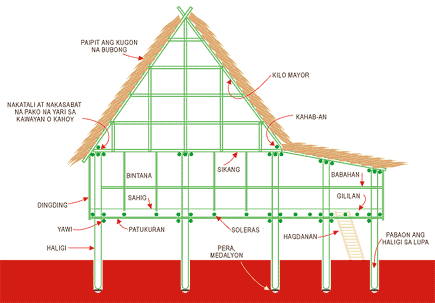By:
Carla M. Pacis
In
the time before the arrival
of the Spaniards, most Filipinos
lived in a bahay kubo, a house
on stilts made of light materials
such as bamboo and nipa for
the roof. This was so, because
when the family needed to move
to another area on which to
grow rice (kaingin), they could
easily dismantle their house
and just as easily build another
one. Eventually, the early Filipinos
settled into villages and built
sturdier bahay kubo's. The house
of the village chieftain was
the largest and most splendid
and was sometimes built up on
the branches of strong, thick
trees. These houses were constructed
of strong and large planks and
had many rooms. But the roof
was still made of nipa. 
The
bahay kubo is essentially a
hand-made house. Even today,
it is still built the same way.
Aside from nipa, the roof could
be made of cogon grass, rice
stalks, sugar cane leaves, split
bamboo and black moss. The leaf
shingles are made by stripping
leaves from the stem and bending
them over a narrow bamboo slat.
The leaves are sown to the slat
with the split stem of buri.
The shingles are then lashed
on to the framework of the roof
with rattan. The posts of the
house (haligi) are made from
molave or from ipil or bamboo.
Holes are dug for the posts
and kept firmly in place by
a circle of buried rock. Once
the posts are in place, the
floor is assembled. The floor
is made of thin bamboo slats
spaced evenly. Light and air
pass through the floors to cool
anyone sleeping on its slats.
At the same time, garbage is
thrown out through the gaps.
The walls of the bahay kubo,
which tend to be tall as they
are long (kubo or cube), are
assembled on the ground. Split
bamboos are woven together to
form sawali. Other materials
such as nipa, coconut leaves,
cogon grass and anahaw leaves
are used to weave into walls.
Doors are attached to a post
with rattan hinges. Shutters
made of thatched nipa or talahib
shingles can be pushed out to
open the window. These are propped
up by bamboo sticks notched
on one end to rest on the windowsill.
The
bahay kubo eventually evolved
into the bahay na bato. By then,
the Spaniards had arrived on
our shores and had greatly influenced
our existing way of life. Now,
there were such rooms as the
kusina, the beranda and the
silid and the bahay na bato
was home to a new generation
of Filipinos. END
(From Philippine Ancestral Houses
by, Fernando N. Zialcita and,
Martin I. Tinio, Jr., GCF Books)
|